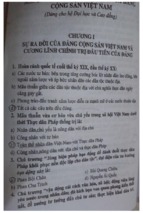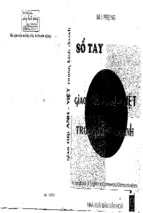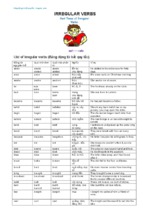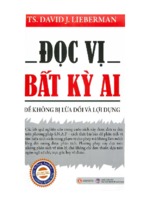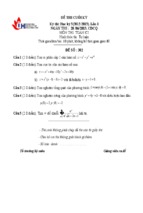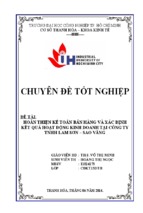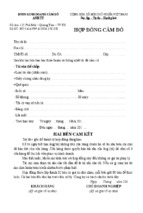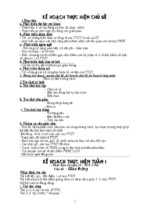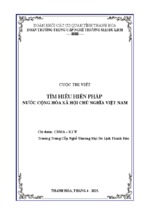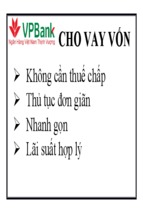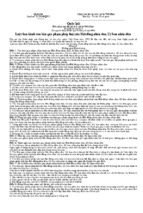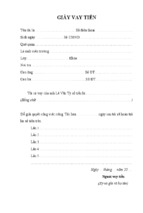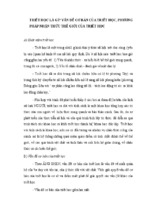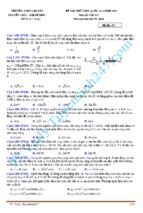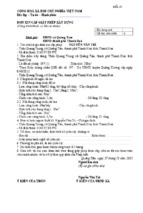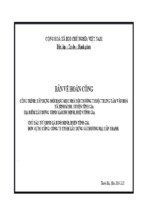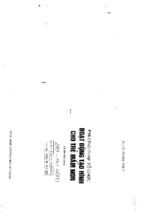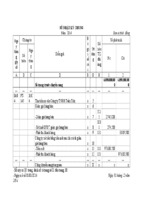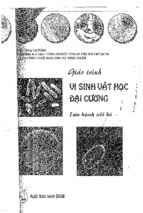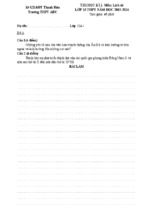MINISTRY OF EDUCATION AND TRAINING
HANOI OPEN UNIVERSITY
M.A THESIS
ENGLISH NEGATION STRUCTURES IN "THE RED AND THE BLACK"
AND THEIR VIETNAMESE TRANSLATION EQUIVALENCE
(Cấu trúc phủ định tiếng Anh trong tiểu thuyết “Đỏ và Đen” và những tương
đương tiếng Việt trong bản dịch)
NGUYEN THI BICH VAN
Hanoi - 2021
MINISTRY OF EDUCATION AND TRAINING
HANOI OPEN UNIVERSITY
M.A. THESIS
ENGLISH NEGATION STRUCTURES IN "THE RED AND THE BLACK"
AND THEIR VIETNAMESE TRANSLATION EQUIVALENCE
(Cấu trúc phủ định tiếng Anh trong tiểu thuyết “Đỏ và Đen” và những tương
đương tiếng Việt trong bản dịch)
NGUYEN THI BICH VAN
Field: English Language
Code: 8.22.02.01
Supervisor: Nguyen Dang Suu
Hanoi - 2021
CERTIFICATE OF ORIGINALITY
I, the undersigned, hereby certify my authority of the study project report
entitled
ENGLISH
NEGATION
STRUCTURES
WITH
THEIR
VIETNAMESE
EQUIVALENTS IN THE NOVEL "THE RED AND THE BLACK" AND ITS
VIETNAMESE TRANSLATED VERSION submitted in partial fulfillment of the
requirements for the degree of Master in English Language. Except where the reference
is indicated, no other person‘s work has been used without due acknowledgement in
the text of the thesis.
Hanoi, 2021
Nguyen Thi Bich Van
Approved by
SUPERVISOR
Assoc. Prof. Dr. Nguyễn Đăng Sửu
Date:……………………
i
ACKNOWLEDGEMENTS
This thesis could not have been completed without the help and support from a
number of people.
First and foremost, I would like to take this opportunity to express my deepest
gratitude to my academic supervisor, Assoc. Prof. Dr. Nguyen Dang Suu for his
conscientious guidance, helpful suggestions, constructive feedback and invaluable
encouragement in the writing of this thesis. Without his professional supervision, my
study would not have been completed.
A special word of thanks goes to all the lecturers at English Faculty at Hanoi
Open University and many others, without their support and encouragement it would
never have been possible for me to have this thesis accomplished.
Last but not least, my wholehearted appreciation goes to my beloved husband and
my family for their love, understanding, encouragement and support to help me
complete this study. They are the power to help me overcome any difficulties while
this thesis was carried out.
ii
ABSTRACT
This study is to further the syntactic features of negative statements and
questions in English and Vietnamese so that the users and students of English will have
an overrall look at negative statements and questions of both English and Vietnamese.
In English, especially in the literary works, negative sentences account for a large
proportion. Much attention has been paid to the patterns and meanings of negative
sentences. However, there has no study of negation in literal work based on "The Red
and The Black" so far. So, my study aims at pointing out the differences and the
similarities of syntactic features between English and Vietnamese negations and
analyzing the negative statements and questions from the English novel "The Red and
The Black" by Standhal and the Vietnamese equivalents in the translated version by
Đoàn Phú Tứ. The main methods used in the study are the discriptive and contrastive.
The thesis delivers the structures and the use of English negative statements and
questions, the similarities and differences between the two languages. The results of
the study may help students get knowledge of negation and negative sentences in
English. Practically, the results will help students use negative statements and
questions in English and Vietnamese effectively. The results of the study will be
somewhat a reference to teachers of English and useful for those who are learning
English as a second language.
iii
LIST OF ABBREVIATIONS
A: adverbial
Adj: adjective
Aux: auxilary
C: complement
Inf: infinitive
N: Noun
NP: noun phrase
O: object
Pr: predicate
S: subject
V: verb
iv
LIST OF TABLES AND FIGURES
Table 3.1. The frenquency of using modal verbs with "not" in negative
31
sentences in the novel.
Figure 3.1. The frequency using "not" in different parts in the sentence
32
Figure 3.2. The frequency of using "no" in different parts in the sentence
33
Figure 3.3. The frequency of using negators in translated version
38
Table 3.2. Negative structures in the source language text and the targer
37
source one
Table 3.3. Equivalent negative structures as predicate negation, subject
negation, clausal negation and adverb negation
v
42
TABLE OF CONTENTS
Certificate of originality
i
Acknowledgements
ii
Abstract
iii
List of abbreviations
iv
List of tables and figures
v
Table of contents
vi
Chapter 1: INTRODUCTION
1
1.1 Rationale
1
1.2 Aims and objectives of the study
1
1.3. Research questions
2
1.4. Methods of the study
2
1.5. Scope of the study
4
1.6. Significance of the study
4
1.7. Structure of the study
5
Chapter 2: LITERATURE REVIEW
6
2.1. Previous studies
6
2.2. Theoretical background
7
2.2.1. Concept of sentence
7
2.2.2. Overview of negation
8
2.2.3. Characteristics of negation
9
2.2.4.1. Scope of negation
11
2.2.4.2. Focus of negation
13
2.2.5. The different forms of negation
15
2.2.6. Three types of negation
16
2.2.7. Double of negation
21
2.2.8. The meaning of negation
24
vi
2.2.9. Negation under some linguists' viewpoint
21
2.2.10. Negation in Vietnamese
24
2.2.11. Brief information of the novel ―The Red and The Black‖
25
2.2.12. Summary
27
Chapter 3: A COMPARISON BETWEEN IN ENGLISH NEGATION 28
STRUCTURES
AND
THEIR
VIETNAMESE
TRANSLATION
EQUIVALENCE
3.1. Syntactic features of negative sentences in terms of the structures of 28
statements and questions in "The Red and The Black" and its translated version
3.1.1 Negative statements in the novel
28
3.1.1.1 Clause negation and local or constiuent negation
28
3.1.1.2 Total negation
29
3.1.2. The syntactic features of negative statements in the novel and its 30
Vietnamese - translated version.
3.1.2.1. Subject negation in the novel
30
3.1.2.2. Predicate negation in the novel
34
3.1.2.3. Object negation in the novel
35
3.1.2.4. Complement negation in the novel
36
3.1.2.5. Adverbial negation
37
3.1.3. The syntactic features of negative questions in the novel and its translated 39
version
3.1.3.1. Negative Yes - No questions
39
3.1.3.2. Negative Wh-questions in the novel
40
3.1.3.3 Tag questions
40
3.2. Similarities and differences of syntactic features of negative statements and 41
questions in "The Red and The Black" and its translated version
3.2.1. Similarities
41
vii
3.2.2. Differences
44
3.3. Implication in using syntactic features of negative statements and questions 45
for Vietnamese learners of English
3.4. Summary of the chapter
46
Chapter 4: CONCLUSION
47
4.1. Recapitulation
47
4.2. Concluding remarks
47
4.3. Limitation of the research
48
4.4. Suggestion for further studies
49
REFERENCES (APA style)
50
APPENDIX
52
viii
CHAPTER I: INTRODUCTION
1.1 Rationale
Theoretically, negation is the topic that is widely discussed within semantics,
pragmatics, morphology and syntax. In general, English and Vietnamese have some
similar features in terms of expressing negation. However, a profound analysis shows
that each language has its own characteristics making some differences in comparison
with other languages.
Practically, the structures of English and Vietnamese negation are considered to
be the most interesting and difficult issues that require a great attention in learning
English as a foreign language. It is the structures that may cause difficulties for learners
in communicating in English and Vietnamese.
Therefore, this study describes, analyses and compares negation structures
between English and Vietnamese. In addition, the investigation into negation structures
in "The Red and the Black" and its Vietnamese translated version by Đoàn Phú Tứ in
order to get more understanding of negation in human language. My choice of the
literary work is "The Red and the Black" which is the works related to human written
language. As the author of this study, the researcher would like to find out how
negation structures are formed and used in written language of the literacy work. Only
by doing so can we understand thoroughly negation and be able to use negation
structures effectively.
1.2 Aims and objectives of the study
1.2.1 Aims of study
In this literature work, negation is used a lot in English and their Vietnamese
translated version. The aim of the thesis is to describe and analyze the syntactic
features of negative sttatements and questions used in "The Red and the Black". On
that basis, the thesis will find out the similarities and differences of negation in English
1
and Vietnamese, which helps students of English understand and use the negative
structures in English and Vietnamese in a better way.
1.2.2 Objectives of the study
To achieve the aims of the study, this thesis focuses on these objectives:
1. To find out the syntactic features of negative statements and questions used in
"The Red and the Black" and its Vietnamese - translated version.
2. To present the similarities and differences of syntactic features of negative
statements and questions between English and Vietnamese used in the work.
-
3. To draw some implications of the thesis for English learners of skills of using
syntactic features of negative statements and questions.
1.3. Research questions
The following are the three research questions
1. What are the syntactic features of negative statements and questions used in
"The Red and the Black" and its Vietnamese - translated version?
2. What are the similarities and differences of syntactic features of negative
statements and questions between English and Vietnamese used in the novel?
-
3. What is the implication of the thesis for Vietnamese learners of English of
skills of using syntactic features of negative statements and questions?
1.4. Methods of the study
1.4.1 Research orientations
The research is conducted on the qualitative and quantitative orientations. The
qualitative research is based on the theories of negation from English grammar books,
documents and researches relating to the research matter which are used to describe
and analyse the characteristics of negation in English and Vietnamese. The quantitative
research is based on the data collected from the novel "The Red and the Black" so as to
analyse, calculate the percentage and find out the similarities and differences of the
characteristics between English and Vietnamese negation. This novel consists of 75
2
chapters, however, this study focuses on 131 statements and questions of negation in
the first 12 chapters.
1.4.2. Research methods
The descriptive and contrastive are considered the two major methods of the
research. These two methods are used to describe, analyse and contrast the syntactic
features of English and Vietnamese negation so that the similarities and differences of
negation between English and Vietnamese will be brought out.
In addition, the statistical, the supporting method is also used in combination
with data collection and data analysis techniques to describe and analyze all the
collected data for the research.
1.4.3. Data collection techniques
All the materials relating to research matter are collected from research works,
grammar books, English novels, Vietnamese books and the internet.
The most suitable materials are chosen for the theoretical background of the
study. Additionally, many examples for illustration in the thesis are collected from
some grammar books, research works and the data collected from English novel, and
their Vietnamese translated version. These examples are the most common - used
negative sentences in English and Vietnamese.
1.4.4. Data analysis techniques
After the data are collected, they are sorted out, classified and analyzed, on the
basis of the syntactic features of negation in the two languages. Then, the researcher
selects the most popular data in English and Vietnamese to make the features of
negation prominent under the study investigation. In the process, all the negative
sentences with negative indicators are grouped into the same kinds. As the research is
realized by descriptive and contrastive analysis, English is viewed as the source
language and Vietnamese is the target language.
3
This part delivers two research questions, criteria for data collection and data
analysis are based on English and Vietnamese grammar books, novel, selected plays,
materials and Internet resources. The major methods include the descriptive and
contrastive in combination with the analytical and statistic supporting techniques.
1.5. Scope of the study
The research focuses on the syntactic features of negative sentences in English
and Vietnamese based on the novel "The Red and the Black' by Stendhal and its
Vietnamese translated version. Negation in English is expressed at different levels,
from word level as "no", "not", "never", phrase level as "by no means", "not in the
least" to the sentence level as "How can I do it by myself?", "I can not understand you"
etc. Within the study in my thesis, however, I only focus on negative statements and
questions. The data and the examples for illustration are collected from the novel "The
Red and the Black" and its Vietnamese –translated version by Đoàn Phú Tứ, from
which all the negative statements and questions are collected by author. Although the
novel is comprised of 75 chapters, in this study, the researcher focuses on analyzing
negative statements and questions in the first twelve chapters
1.6. Significance of the study
Theoretically, the research results may help students enrich their theory of
negation in English with reference to Vietnamese. The study will also help students of
English understand profoundly the theory and features of negation. The author will, to
some extent, make certain contribution to a better way of teaching the English negative
sentences to the students of English.
Practically, the result of the study will help students of English use negation,
negative statements and questions in English and Vietnamese effectively in their
learning, working proccess and achieve better communication in English after
graduation from university as well.
4
1.7. Structure of the study
The thesis consists of 4 chapters as follow:
Chapter 1 is the Introduction of the study which shows the reasons why the topic
is chosen, what the research aims at as well as the scope, the significance and the
structural organization of the study.
Chapter 2 is the Literature review and Theoretical background of the study. This
chapter will give the brief review of related literature and theoretical background of
every matter mentioned in the study.
Chapter 3 is the Findings and Discussions. It presents and analyzes the collected
data from questionnaires as well as gives the similarities and differences of of syntactic
features of negative statements and questions between English and Vietnamese used in
the work.
Chapter 4 is the Conclusion of the study which presents the recapitulation of the
study, the limitations of the study and some suggestions for further study.
5
CHAPTER II: LITERATURE REVIEW
2.1. Previous studies
Jeperson (1917) in "Negation in English and other languages" paves the ways
for the studies of negation later. He provides the readers with general tendencies of
negation strengthened and weakened negatives, indirect and incomplete negation and
the meaning of negation. He also shows that negation can be complete with nuclear
negators like not, no, never, or incomplete with hardly, scarcely, a little, few. Among
them, "NOT" is followed by auxiliary verbs to negate the whole sentence.
Klima (1964) supplies variety of sentences with such quite distinct "negative"
words as "not, none, never". He is trying to show several criteria for differentiating a
class of "negative sentences". His approach is a syntactic one which aims at
grammatical correctness and proper use of the negation.
Tottie (1991) puts forward a classification of the uses of negation in both oral
and written language in "Negation in English Speech and Writing". Horn, L.R. (1989)
in "A natural History of Negation" presents the semantic features and scope of
negation. Vietnamese grammarians and linguists have investigated into negation from
different perspectives but mainly focus on traditional, structural of lo gical perspectives
such as Hoàng Trọng Phiến (1980), Nguyễn Đức Dân (1996), Đỗ Thị Kim Liên, Diệp
Quang Ban (2004, 2006), Mai Ngọc Chừ, Vũ Đức Nghiệu. In adition, Nguyễn Quang
has also investigated negative sentences in English and Vietnamese on a contrastive
analysis in his master thesis. Especially, Trần Văn Phước in his doctor thesis "Phân tích
đối chiếu câu phủ định tiếng Anh và tiếng Việt trên bình diện cấu trúc ngữ nghĩa"
systemized the syntactic-semantic features in both English and Vietnamese declarative
sentences as well as analyzed the differences and similarities of syntactic -semantic
features in the two languages. He suggests 17 negative sentence structures and 61
variations in English as well as 64 variations in Vietnamese. Then Ms Tran Phuong
Thao from Danang University conducted "An Investigation into English Lexical
6
Devices Denoting Negation versus Vietnamese Equivalents" (2010), in which the ways
that express the conception of negation in English and Vietnamese equivalents are
clarified. All these books and studies revealed typical and very interesting features of
negation in general as well as negation in English and Vietnamese in particular.
However, there has been no investigation into a particular novel ―The Red and the
Black‖ so far. Therefore, the investigations into negative statements and questions in
"The Red and the Black" by Standhal are conducted in attempt to find out the syntactic
features of negation with reference to their Vietnamese equivalents in the Vietnamese translated version by Doan Phu Tu.
Overall, all most aspects of negation are analyzed and compared in the researches
above such as sociology, anthropology, socio-linguistics, and discourse analysis.
However, these studies only focus on negation in English and Vietnamese. The
researcher strongly desires to help teachers and students use this in better way.
2.2. Theoretical background
This chapter offers the theoretical background relating to the research area. First
of all, we should deal with the concept of sentence.
2.2.1 Concept of sentence
According to Oxford Advanced Learner' Dictionary 10th edition published in
2020, a sentence is a set of words expressing a statement, a question or an order usually
containing a subject and a verb. In written English, a sentence begins with a capital
letter and ends with a full stop/ period (.), or a question mark (?), or an exclamation
mark (!).
A sentence is defined as a group of words which convey certain meaning to a
reader. As far as structural grammar is concerned, a sentence often contains a subject
and a predicate. The predicate includes verb or verb phrase and complement which
consists of a predicative or an object. It may contain a clause (simple sentence). A
sentence may consist many clauses in which there is at least one main clause and one
7
subordinate clause (complex sentence), two main clauses co-ordinated by a conjunction
(compound sentence). For example:
- He is very kind - hearted. simple sentence
- He is a teacher who taught me English at secondary school. complex sentence
- He is an engineer and his wife is a university teacher. compound sentence
Quirk, R.et al (1985) stated that English sentence structure includes the
following basic parts: subject (S), verb (V), complement (C), object (O), Adverbial (A)
which have fundamental linguistic features as follows:
Subject (S): Subject is a noun, noun phrase or pronoun presenting a person or
thing that performs the action of the verb. For example: I sat down quitely. The house
is not so large.
Verb (V): Verb is a word or a group of word that expresses an action such as
eat, an event such as happen or a state such as exist. For example: She sings very
beautifully.
2.2.2 Overview of negation
There have been many definitions of negation in English. In the Longmann
Dictionary of Language Teaching and Applied Linguistics, negation is defined as
"contradicting the meaning or part of the meaning of sentence."
Horn (2010) gives out the definition of negation: "In many ways, negation is
what makes as human, imuing us with the capacity to deny, contradict, misrepresent,
lie, and convey irony." (p.1).
Lindstadd (2007) argues, "Negation is a language univeral, found in all known
languages, and unique to human languages." (p.3). A further uniform characteristic is
that sentential negation (including what could be termed "clausal negation) always
involves "the addition of an overt morpheme to an affirmative clause". (Lindstadd
2007: 24). The function of negation is fairly straightforward: it negates parts of or the
entire sentence or clause.
8
And Longman Dictionary of Contemporary English, published in 1994 shares
the same and adds some more information that "Negation is the act of stating that
something does not exist or is untrue", furthermore, the Vietnamese Dictionary
published in 1998 by the Centre of dictionary and Danang Publishing House says that
negation is the act of rejecting the existence, the necessity of something; the opposition
of affirmation. Collins Cobuild, 1990, p.206) concludes, "Negation is used when you
want to say something is not true, is not happening, or not the case."
William Bright states in the International Encyclopedia of Linguistics (1992)
that virtually, all linguistic categories from clause to individual word can in principle
be negated - although, in practice, individual languages display arbitrary restrictions.
Each langauge possesses a form of standard, or canoical negation whose primary
function is to negate the positive declarative main clauses of the language. [4,75]
The authors of The Oxford Dictionary of English Grammar say that negation is
the grammatical means by which the truth of an assertive (or positive sentence or
clause is denied. Typically, an English sentence or clause is negated by adding "not"
or "n't" to the primary verb, or to the first auxilary verb. This is called clausal
negation. For example: This is not difficult. He couldn't have been there. [1,262]
Although there is a wide variety of definitions of negation, I myself totally agree
to some main points as follows:
Negation is a part of people's cognition activity and communication process. It
is a basic category of thinking, of formal logic. It is the opposition of the affirmative
category.
2.2.3. Characteristics of negation
Huddleson and Pullum (2002) provides a clear description on the characteristics
of negation in English.
Unlike affirmation, negation can be identified by words (e.g, not, no, never, not
any) or affixes (e.g, dis, un-). Negation can interact with other words in special ways.
9
For example, negated clauses use more different connective adjuncts than positive
clauses do: neither, nor instead of either, or. The so - called negatively oriented
polarity - sensitive items (Huddleston and Plum 2002) contain among many others,
words starting with any (anybody, anyone, anywhere, etc.), the modal auxilaries dare
and need and the grammatical units at all, much, and until. Negation in verbs usually
requires an auxilary; if "none" is present, the auxilary do is inserted (I read the paper
vs I didn't read the paper). Negation involves some major contrasts: verbal vs non verbal, analytic, clausal vs sub-clausal.
Verbal
Non-verbal
- He doesn't dine out.
- He never dine out.
- He did not see anything at all.
- He saw nothing for me.
Analytic
- Not many people like it.
non-analytic
- Nobody like it.
Clausal
- She didn't have a large income.
Sub-clausal
- She had a not inconsiderable income.
In verbal negation, the marker of negation is grammatically associated with the
verb, the head of the clause, whereas in non - verbal negation, it is associated with a
dependent of the verb: an adjunct as in (never dines out), an object as in (saw nothing).
Analytic negation is marked by words whose sole syntatic function is to mark
negation, ie not and also no in the use in which it contrasts with yes, as in answering a
question, for example, synthetic negation is marked by words which have some other
function as well. Synthetic verbal negation is marked inflectionally, by negative verbal
forms. Synthetic non - verbal negation is marked by elements of three kinds:
a. Absolute negators: no (including compounds nobody, nothing, not any etc.,
and the independent form none, neither, nor, never.
b. Approximate negators: few, little, barely, hardly, scarcely, rarely, seldom.
c. Affixal negators: un, in, non-, -less, ir-, il-, etc.
10
- Xem thêm -


